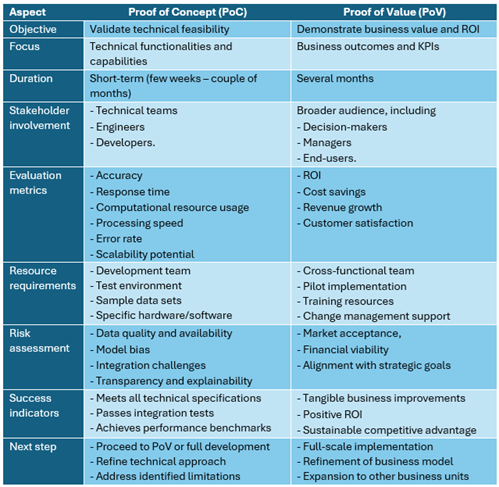

How to Adopt AI to Get Real Business Value?
Dr Umair Ali Khan, 19.12.2024


Even with major advancements in artificial intelligence (AI), many companies find it hard to turn these innovations into real business benefits. A report by Boston Consulting Group (BCG) found that, out of over 1,000 companies surveyed worldwide, only 4% have developed strong AI capabilities across their operations and are consistently seeing significant value. Meanwhile, 74% have not achieved any clear benefits from AI, largely due to issues with people and processes rather than technology itself (BCG, 2024). Similarly, a McKinsey & Company survey indicates that while AI adoption has surged, many organizations remain in the early stages of implementation, often lacking a clear strategy to harness AI’s potential effectively (McKinsey & Company, 2024). Another recent study by Mindtree (Mindtree, 2024) found that although 85% of organizations have a data strategy and 77% have invested in AI-related technologies, only 31% have seen a return on their investment.
In our AI consultancy in the FAIR EDIH project (FAIR n.d), we found that most companies are inspired by the theoretical prospects of AI mentioned in scientific or technical studies. However, they face challenges in identifying and defining the gap between theory and practice. While most of the AI methods look plausible in academic studies, their practical application could be challenging. This gap between AI development and achieving business value indicates that companies often start AI projects without properly considering how they will benefit the business or aligning them with strategic goals, leading to disappointing returns on investment.
As AI becomes more integral to business operations, it is essential for all employees, including decision-makers and managers, to gain a basic understanding of AI concepts. However, many companies view AI adoption as purely a technical task, neglecting the importance of upskilling non-technical staff. This narrow focus often leads to projects driven by AI trends rather than strategic business goals, resulting in a superficial approach that overlooks thorough evaluations of business impact and return on investment (ROI). Consequently, companies also have tendency to concentrate on Proof of Concept (PoC) projects without fully understanding their purpose, mistakenly equating them with assessments of business value.
What is Proof of Concept?
A PoC is a preliminary implementation designed to verify the technical feasibility and functionality of a proposed solution. In the context of AI, a PoC involves developing a prototype to assess whether an AI solution can effectively address a specific problem. Initiating a PoC is advisable when exploring new ideas that lack prior technical validation.
For instance, if a company considers developing an AI system that can predict patient’s waiting time in a healthcare facility – a concept studied in the literature with varying parameters and performance – a PoC can demonstrate feasibility to stakeholders within a limited timeframe. This approach is particularly useful when there is uncertainty about the implementation’s viability, because this system may depend on several factors including the availability and adequacy of data, analyzing the impact of different combinations of predictors, and other regional aspects.
On the other hand, developing a PoC may be unnecessary if the proposed solution is well-documented and aligns with established industry practices. For example, deploying a chatbot for customer service with a company’s internal documents, a solution widely adopted and technically straightforward, might not require a PoC. In such cases, resources can be directed toward full-scale implementation rather than preliminary validation.
The benefits of conducting a PoC include early identification of potential challenges, allowing for adjustments before significant investments are made. This approach minimizes business risks by enabling the testing of new ideas incrementally, rather than committing to extensive projects without prior validation. Additionally, a successful PoC can attract investors and secure stakeholder support by demonstrating the solution’s potential. It also facilitates resource optimization by uncovering business or process-related issues early, providing an opportunity to address them before full-scale deployment. That said, PoC is more focused on demonstrating the technical feasibility of an idea and does not determine the business value.
Why PoC is not Enough?
According to the Boston Consulting Group (BCG, 2024), companies adopting AI can be grouped into four categories: inactive (25%), experimenters (49%), scalers (22%), and value drivers (4%). Inactive companies have little to no AI activity. Experimenters focus on Proof of Concept (PoC) projects to test the technical feasibility of AI without moving toward full implementation. Scalers expand AI applications to create measurable business value, while value drivers integrate AI as a core part of their operations, consistently delivering significant benefits such as improved productivity, increased revenue, and a competitive edge. Interestingly, over half of the scalers and value drivers are not “born-digital” companies but have advanced their AI capabilities to achieve meaningful results.
While PoCs are a critical step in testing whether an AI solution can work technically, they often fail to address key aspects like scalability, long-term value, or real-world impact. An AI model that performs well in a controlled test environment may not deliver the same results when scaled, leading to issues such as integration challenges and unmet expectations. This is the reason why many companies get stuck at the PoC stage, creating impressive demos and presentations about how AI works, but they fail to turn these efforts into real business results.
To successfully adopt AI, companies must move beyond PoCs and focus on Proof of Value (PoV), which evaluates both technical feasibility and tangible business benefits. PoV ensures that AI projects align with strategic goals and address real-world challenges. This approach shifts the emphasis from simply proving that AI works to demonstrating how it can create measurable value, helping businesses achieve meaningful and sustainable outcomes.
What Is Proof of Value?
PoV is a process that extends beyond demonstrating technical feasibility to assess the tangible business benefits and ROI of a proposed solution. Unlike PoC, which focuses on validating whether a solution can be implemented, PoV emphasizes evaluating the measurable value the solution can deliver to an organization. This approach involves detailed business use cases to explore why an organization should adopt the PoC solution, helping to justify adoption and measure success. In many cases, PoV is followed by a successful PoC.
Consider a healthcare tech company developing an AI tool to detect early-stage Alzheimer’s disease by analyzing eye movements. While many studies show that AI models analyzing eye movement data can differentiate between individuals with Alzheimer’s and healthy controls (Liu et al., 2024), its real-life implementation in a healthcare setting is challenging. Informed by the literature review, the company should first develop an initial PoC that uses AI to identify unusual eye movement patterns associated with Alzheimer’s. This prototype is tested in a controlled setting to ensure it accurately detects these patterns and works well with existing medical imaging systems.
After confirming the technical feasibility, the company should move to the PoV stage, focusing on real-world benefits. They conduct pilot studies with healthcare providers to evaluate the tool’s effectiveness in clinical environments. Key metrics include diagnostic accuracy, time saved in diagnosing patients, and cost reductions compared to traditional methods. They also assess patient outcomes and satisfaction to ensure the tool improves overall care quality. By examining these factors, the company determines the AI tool’s ROI and its suitability for widespread clinical use.

What Factors Should Be Considered for a PoV?
From our experience in AI consultancy, we have noticed that companies starting their AI journey often overlook PoV. Many assume they already understand the business value of their AI projects and focus too much on PoC. However, figuring out business value is not just about assumptions. It requires careful planning and a clear approach. Here are some essential aspects of a PoV.
- Define and evaluate a use case: To begin creating a PoV, start by identifying a clear and specific use case for the AI solution. Many companies have several use cases with no clear objectives. Define measurable success metrics that will help evaluate the solution’s impact. These metrics could include reduced costs, faster response times, shorter processing periods, improved customer experiences, or increased revenue. Clearly defined outcomes ensure that measurable value remains the ultimate goal of the project.
Selecting the right use cases is critical for a successful PoV. Decision-makers must avoid overemphasizing return expectations during early stages, such as the PoC phase. Doing so can limit innovation and slow down the development of effective solutions. At the same time, neglecting to actively measure the value contribution risks wasting resources on unimportant use cases or pursuing AI without a clear purpose (Applied AI, 2021).
After selecting a use case, it’s important to assess its feasibility and potential impact by asking key questions. Can the problem be clearly defined? For example, creating an AI system to automatically generate requests for quotations. Is the necessary data available to train and test the AI models, such as text or image data from past quotations? What is the expected ROI, such as saving time, reducing errors, or increasing efficiency? Answering these questions helps focus on use cases that bring the greatest value to the business.
- Measure internal and external value: Identify and calculate the returns from a use case by separating internal and external value. Internal value comes from improving core business processes and operations, such as enhancing product quality, speeding up workflows, saving time, or making better decisions using data. External value, on the other hand, is created through market-facing activities like launching new products or services, developing innovative business models, upgrading existing offerings, or boosting customer loyalty and satisfaction.
- Align the AI project with business objectives: Make sure the AI project is closely aligned with the company’s business needs and objectives. For example, a manufacturing company planning to develop an AI solution to automatically recognize equipment and their labels in a virtual tour of the factory should ensure the project addresses specific operational challenges. This solution could be aimed at enhancing inventory management, improving maintenance processes, or enhancing safety checks.
- Demonstrating value to stakeholders and users: Show how the AI solution will provide real value to stakeholders, customers, and users. This can be done by using methods like literature reviews, case studies, or surveys to gather evidence of the solution’s potential benefits. For example, a retail company developing an AI-driven recommendation system for improving customer service could use studies from similar businesses to demonstrate how such a system has improved customer satisfaction and improved sales. Additionally, surveys of potential users could provide insights into their expectations and how the solution might meet their needs.
- Ensuring integration and sustainability: Evaluate how the AI solution will integrate with the company’s existing systems and processes. Check if it can remain effective as business needs, market conditions, and organizational goals evolve. A sustainable AI solution should consistently deliver value over time and adapt to new business challenges or advancements in technology. For instance, a company deploying a chatbot must ensure it can integrate with the company’s internal information sources. This chatbot could provide precise answers to employees’ queries about internal processes, assist decision-makers with data insights, and enhance customer experience by delivering accurate and timely information.
- Determine the scope of the AI solution: Determine if the planned AI project can be adapted for multiple purposes or extended beyond its initial use case. An AI solution that can be applied to various scenarios or departments within an organization significantly increases its overall value. For example, a Retrieval-Augmented Generation solution (an increasingly popular GenAI method in which a company’s internal data is integrated with a large language model) initially implemented to provide customer support could also be adapted for internal knowledge sharing among employees or as a tool for decision-makers to quickly access relevant business data. This flexibility makes the solution more impactful and cost-effective across different parts of the organization.
- Addressing capability gaps: Evaluate your company’s gaps in critical capabilities compared to industry leaders and invest in building these capabilities. While it may be important to initially focus on technical aspects like data quality and infrastructure, equally vital are people and processes, which require ongoing attention and development (BCG, 2024). For example, a healthcare organization aiming to develop an AI solution to predict cardiac diseases might discover gaps in its data integration processes or the technical expertise of its team. By addressing these gaps, such as upskilling healthcare staff in AI concepts, hiring required technical expertise, and/or improving data-sharing protocols with hospitals, the organization can strengthen its foundation for successfully implementing and scaling the solution.
- Calculating investment costs across the AI lifecycle: Evaluate the total costs involved in developing and maintaining the AI solution over its entire life cycle. This includes costs for initial planning, data collection, hiring skilled professionals, procuring necessary hardware and software, system development, deployment, validation, and ongoing monitoring and maintenance. For example, a healthcare organization planning to develop an AI decision support system for managing chronic illness care needs to calculate costs for collecting patient data, hiring technical experts, purchasing AI tools and infrastructure, building the system, deploying it in clinical settings, conducting thorough clinical validation, and maintenance.
- Addressing ethical and legal considerations: Understand the ethical and legal implications of the AI solution being developed. This includes becoming familiar with regulations like the AI Act and data privacy laws such as GDPR. These frameworks set guidelines for the responsible use of AI, especially in sensitive applications, and can introduce restrictions that may impact large-scale adoption. For example, a company developing an AI system for the early detection of dementia through facial analysis must ensure compliance with data protection regulations to safeguard patient privacy. Additionally, the system must address ethical concerns such as consent, data bias, and transparency to build trust with both users and stakeholders. Awareness of ethical implications is especially important under the current AI Act (European Parliament and Council, 2024), which classifies AI applications into different risk levels and applies specific restrictions based on those risks. This act will be gradually in place in the upcoming years.
- Adopt a co-development approach: Many companies assume that AI development is purely a technical process involving only developers. However, AI adoption requires a multidisciplinary approach that involves all stakeholders. The development process should include not just technical experts but also decision-makers and management teams. Providing basic AI training to these non-technical stakeholders is crucial to ensure they can contribute effectively and align the AI solution with business goals.
In conclusion, to ensure successful AI adoption, companies must go beyond PoC and focus on PoV to assess how the solution can deliver tangible benefits. Simply following AI trends or implementing AI without a clear purpose often leads to failed projects and wasted investments. A strategic approach that incorporates both PoC and PoV is essential for leveraging the true potential of AI and creating meaningful business impact.
Contact

Umair Ali Khan
Senior Researcher
+358 29 447 1413
umairali.khan@haaga-helia.fi
References
Applied AI. (2021). Value assessment of AI products and applications. Available at https://aai.frb.io/assets/files/appliedAI_Value-Assessment-of-AI-Products-and-Applications.pdf. Read 27/11/2024.
BCG. (2024). Where’s the value in AI? Available at https://www.bcg.com/publications/2024/wheres-value-in-ai. Read 27/11/2024.
European Parliament and Council. (2024). Regulation (EU) 2024/1689 of 13 June 2024 laying down harmonised rules on artificial intelligence and amending certain Union legislative acts (Artificial Intelligence Act). Official Journal of the European Union, L 1689, 1–144. Available at https://eur-lex.europa.eu/eli/reg/2024/1689/oj. Read 27/11/2024.
Finnish AI Region (FAIR). (n.d.). Available at https://www.fairedih.fi/en/frontpage/. Read 27/11/2024.
Liu, Y., Zhang, W., Wang, S., Zuo, F., Jing, P., & Ji, Y. (2024). Depth-induced saliency comparison network for diagnosis of Alzheimer’s disease via jointly analysis of visual stimuli and eye movements. arXiv. Available at https://arxiv.org/abs/2403.10124. Read 27/11/2024.
McKinsey & Company. (2024). The state of AI in early 2024: Gen AI adoption spikes and starts to generate value. Available at https://www.mckinsey.com/capabilities/quantumblack/our-insights/the-state-of-ai. Read 27/11/2024.
Mindtree. (2024). Gen AI adoption report: Unlock the power of generative AI platforms. Available at https://www.ltimindtree.info/gen-ai. Read 27/11/2024.


Finnish AI Region
2022-2025.
Media contacts